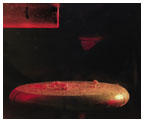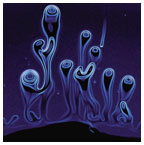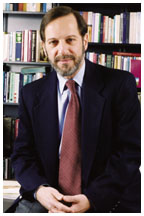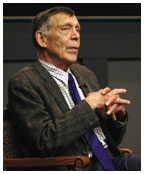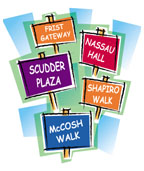June 8, 2005: Notebook
Have an opinion about this issue of PAW? Please take a minute to click here and fill out our online survey. It’s an easy way to let the editors know what you like and dislike, and how you think PAW might do better. (All responses will be anonymous.) |
Drawing a line between scholarship and politics
’95 fund supports student aid projects overseas
Breaking ground—geosciences
Beneath the ocean, clues to climate change
Professors add ‘emeritus’ to their résumés
Challenging
young urban pupils to succeed
Jason Kamras ’95, the National Teacher of the Year, works
for an ‘even playing field’
Jason Kamras ’95 reviews an assignment with seventh-grader William Williams. (Maya Gilliam, D.C.P.S.) |
For Jason Kamras ’95, teaching math at John Philip Sousa Middle School isn’t just a job. It’s about leveling the playing field for his students, who live in a neighborhood of brick apartments in southeast Washington, D.C. Students must pass through metal detectors to enter the school each morning; the principal walks the halls with a bullhorn.
“Poverty is too often used as an excuse to lower expectations for children in low-income communities,” said Kamras. He demands a lot from his students and himself, with impressive results: In April, he was named the 2005 National Teacher of the Year. “What Jason has proven,” said principal William Lipscomb, “is that the kids in the inner city can learn if they are matched up with a teacher of his caliber.”
Days after receiving the honor from President Bush in the Rose Garden, Kamras was back at school. Fifteen seventh-grade boys (in an experiment, Kamras’ classes are separated by gender) lined up outside Room 219 for math class. Kamras, who is not much taller than his charges, greeted each one at the door. Room 219 — neat and organized, with students’ portfolios lining bookcases — had a sense of calm and purpose. Sitting three or four to a table, the boys worked on problems built around questions such as “How old is Mr. Kamras?” and “How tall is the Washington Monument?” Kamras floated around the classroom, working one-on-one with students who needed help.
Order and discipline matter, said Kamras, “because that facilitates learning and makes students feel comfortable.” But so does fun. He jokes with students, draws them out, and engages them by using puzzles, collaborative activities, and original games such as “mathopoly” and math aerobics (students form angles and geometrical figures with their bodies). He has revamped the math curriculum to give lessons a real-world context and to emphasize technology. For example, with the true-or-false question “–7 is greater than –1” displayed on an LCD screen in front of them, students pointed blue clickers at a receiving box at the front of the room. As the students pressed A for true or B for false, their answers were tabulated instantly on the screen.
In addition to teaching, Kamras mentors first-year teachers and is team leader for the seventh-grade teachers. He comes in early, around 7:15 a.m., to offer extra instruction to students getting ready for standardized tests. He also successfully lobbied the principal to double class time for math instruction, from one to two 50-minute periods per day, five days a week. (The school cut back on electives to make room in the day.) These curricular changes helped reduce the percentage of students scoring “below basic” on standardized math tests from 80 to 40 percent in a single year.
A photography enthusiast, Kamras also started an after-school photography program, EXPOSE, in which children learn how to use digital cameras, edit images, and create photo essays about their lives and communities. EXPOSE “gives my students a chance to tell their own stories, unfiltered by popular culture or the media,” he said.
Kamras’ math class is “one of the few classes that students break the door down to get in,” Lipscomb said. Teacher Megan Douglas added that Kamras “knows how to talk to kids in a way that they really understand.”
Kamras, whose mother was a teacher, came to John Philip Sousa in 1996 through Teach for America, which places recent college graduates in under-resourced public schools for two years. The school is just the type Kamras is committed to serving — one that faces many socioeconomic challenges and is in need of teachers. About 95 percent of the 400 students in sixth through eighth grades receive free or reduced-price lunches; many live in single-parent homes.
A Woodrow Wilson School major at Princeton who earned a master’s degree in education from Harvard, Kamras first worked with low-income youth as a volunteer tutor in Sacramento, Calif., during the summer between his sophomore and junior years of college. That experience inspired him to tutor elementary school students in Trenton through the Student Volunteers Council.
As National Teacher of the Year, he receives a one-year sabbatical to speak out on educational issues and promote the teaching profession. He hopes to use his platform to raise awareness of inequities in staffing and resources between urban and suburban schools. “It’s perhaps our most solemn obligation as a country,” he said, “to ensure that the playing field is even for our children.”
Kamras, a D.C. resident who is single, spends almost 12 hours a day at school and comes in Saturdays to prepare for the week ahead. “I’m always pushing myself to be more creative, to develop activities that spark enthusiasm,” said Kamras. He calls his students on weekends and makes home visits.
When one of Kamras’ first students at John Philip Sousa, Wendall Jefferson, was having trouble in sixth grade, Kamras played chess with him once a week, tutored him after school, and got to know his mother. Jefferson graduated from middle school in 1999 as valedictorian. Kamras continued to tutor him in math and science through high school and helped him study for the SATs. Today Jefferson is a sophomore at Morehouse College majoring in electrical engineering, the first person in his family to go to college. He attended the White House ceremony with Kamras.
“It’s important to recognize the challenges that children
have and support them in addressing those challenges [of poverty], but
not let them off the hook” in terms of achievement, Kamras said.
“And what I have found is they rise to the occasion.” ![]()
By K.F.G.

(Courtesy art of science competition) |
“Plasma Table,” by Elle Starkman and Andrew Post-Zwicker of the Princeton Plasma Physics Laboratory, above, won the $250 first prize in the University’s first Art of Science competition. The image shows a dust cloud of silicon microspheres illuminated by laser light and suspended in a plasma.
The second-prize winner, right, is “Driven” by research staff member Anton Darhuber (electrical engineering), Benjamin Fischer *03 (chemical engineering), and Professor Sandra Troian (chemical engineering). It depicts patterns formed during the spreading of a surfactant over a thin liquid film on a silicon wafer.
More than 100 students, faculty, and staff members submitted entries
in the competition, designed to celebrate the aesthetics of research and
the intersection of art and technology. Said Dean of the Faculty David
Dobkin, one of the contest judges: “The images present an interesting
lens into the world that scientists look at every day.” More than
55 images will be on display for several months in the hallway of the
Friend Center’s main floor. They also can be viewed at http://www.princeton.edu/artofscience/gallery.
![]()

Drawing a line between scholarship and politics
Columbia professor Rashid Khalidi’s candidacy for a Princeton position has aroused controversy. |
Columbia University Arab studies professor Rashid Khalidi’s candidacy for an endowed chair at Princeton drew objections in late April from some students and alumni concerned with the professor’s public statements. Though the situation cooled as the search for the Robert Niehaus ’78 Chair in Contempo-rary Muslim Studies moved forward, it raised questions about separating politics from scholarship and teaching.
Khalidi, who specializes in the history of Syria, Palestine, Lebanon, and Egypt, has been an outspoken critic of Israel and American policy in the Middle East. When the New York Sun reported in early March that Khalidi was considering a move to Princeton, alumni e-mailed news stories and columns to University administrators, asking them to take note of the professor’s controversial background. Said Vice President and Secretary Robert Durkee ’69, “If someone expresses concern, and some people have, certainly we are going to listen.” Though he did not quantify the number of people expressing concern, Durkee said that the criticism centered on Khalidi’s public statements, not his scholarship, and “a person’s political views are not something that would get considered as part of the search process.”
Khalidi lectured at Princeton on March 31 in a full auditorium at McCormick Hall, speaking about the history of democracy in the Middle East and presenting historical examples to dispute the perception that Islamic nations in the Middle East are inhospitable to democracy. After his speech, Khalidi fielded questions for about 45 minutes in a collegial atmosphere.
But newspaper articles have portrayed Khalidi in a different light, reporting that he called Israeli policies “racist” and compared Israel’s political system to apart-heid. (Both comments, he told the New York Times, were taken out of context.)
Arlene Pedovitch ’80, the interim director of the Center for Jewish Life (CJL), told the Daily Princetonian in April that some students and alumni were concerned about hiring “an individual who has a political agenda rather than a scholarly approach to history.” But others, including CJL board chairman and economics professor Henry Farber *77, said Khalidi deserved to be considered for the Niehaus Chair. In a letter to the Prince, Farber wrote that Pedovitch’s concerns were “misplaced.”
Professor Stanley Katz, a former president of the American Council of Learned Societies and a former CJL board president, acknowledged that the distinction between politics and scholarship is not always clear, particularly in fields that deal with contemporary events, such as Middle East studies. “There is no bright line, and there are going to be hard cases,” Katz said in an interview with PAW. “I don’t happen to think Khalidi is a hard case.” Khalidi deserves consideration for the Niehaus Chair based on his strong record of scholarship, Katz said.
Some students remain concerned, including Dylan Tatz ’06, chairman of the Princeton Committee on Prejudice. While the Niehaus Chair provides an opportunity to bring a unifying voice to the Mideast debate on campus, Tatz said, Khalidi may “reinforce existing divisions.”
According to Durkee, the Niehaus Chair committee was still narrowing
its pool of candidates in May. A final candidate must be approved by the
department in which he or she will serve before being presented to the
Faculty Advisory Committee on Appointments and Advancements, which will
evaluate the candidate’s scholarship and teaching with assistance
from experts in the field. A final candidate will not be presented to
the Board of Trustees before September, according to Professor Miguel
Centeno, the chairman of the search committee. ![]()
By B.T.

Photo by John Jameson ’04 |
LectureCircuit
“There are so many things that a dance can be — so many possibilities. ... I always hope my pieces and subject matter are universal, with ties to all time and so that all people can relate to it.”
Dancer and choreographer Paul Taylor, who spoke April 29 at the Stewart
Theater at 185 Nassau St. He first presented his choreographed work in
Manhattan in 1954, and his two dance companies, the Paul Taylor Dance
Company and Taylor 2, continue to perform around the world. ![]()

’95 fund supports student aid projects overseas
Suneel Bhat ’06 coordinated the construction last summer of this two-room school in Bangane, a remote village in India, with help from the ’95 Summer Service Fund. (Courtesy Suneel Bhat ’06) |
In the summer after his freshman year, John Smith ’95 wanted to volunteer in Ukraine with organizations providing medical relief to children affected by the Chernobyl disaster. So he went looking for assistance from the University and was introduced to a generous range of alumni support — the Class of 1942 Horton-Elmer Fund, the Fred Fox ’39 Fund, and several others.
“I just remember being amazed at how supportive these alumni were of undergraduates trying to go out in the world and do good things,” Smith said.
Three years later, as president of his senior class, Smith joined classmates to extend the same type of support to future Princetonians, making the Class of 1995 the youngest to establish a service fund. As the class celebrated its 10th reunion in May, five students received a total of $5,000 in grants from the ’95 Summer Service Fund, which has supported the summer projects of more than a dozen undergraduates over the last six years.
From its inception, the ’95 Summer Service Fund committee has relied on assistance and advice from its forebears, including Princeton Project 55 and the Class of 1969 Community Service Fund. But the ’95 group is very much a product of the Internet generation, communicating through e-mail and virtual meetings.
The fund caters to students who are entrepreneurial in their approach to service, instead of placing students in established programs. “We look for someone with a creative idea and who has been able to identify the resources to make it happen,” said Elyse Michaels Berger ’95, who co-chairs the fund’s committee with Smith.
In 2003, Kelechi Acholonu ’05 returned to her birthplace of Obohia, Nigeria, to create a library for the local high school, and last year, Suneel Bhat ’06 organized the construction of a two-room schoolhouse in Bangane, an isolated village in southern India. Both projects required local knowledge and extensive planning. Dan Marcus ’95, who heads the fund’s selection committee, said the projects are meant to be a “building block” for students considering careers in public service.
This year’s winners will continue the fund’s trend of international service. Soraya Umewaka ’06, who spent previous summers working with street children in Lebanon and Afghanistan, will volunteer at a children’s center in Quito, Ecuador. Josh Williams ’07 will stage community theater productions in Kenya to promote AIDS and HIV awareness. Caroline English ’08, an experienced volunteer for Habitat for Humanity, will build homes in Tanzania. Maital Friedman ’07 will work with orphans of AIDS patients in Uganda. And Nathalie Moise ’05 will split her summer between Belize and the Bronx, promoting AIDS education in both places.
Smith said each trip has the potential to transform the student involved,
and he speaks from experience. Last December, the lawyer from Washington,
D.C., took a break from his day job to return to Ukraine as an official
observer for the nation’s presidential election, in part because
of the path of service he first traveled more than a decade earlier. The
summer helping the children of Chernobyl, Smith said, instilled an understanding
of “how much good just a little help can do.” ![]()
By B.T.

George T. Reynolds *43, the Class of 1909 Professor of Physics, emeritus, died in Skillman, N.J., on April 19 at age 87. Reynolds, who was a researcher for the Manhattan Project, directed Princeton’s high-energy particle physics program for more than two decades and was an innovator in biophysics in the early 1970s.
Walter Johnson, the Arthur LeGrand Doty Professor of Electrical Engineering, emeritus, died April 22 in Hightstown, N.J. He was 92. Johnson, who joined the Princeton faculty in 1937, chaired the electrical engineering department from 1950 to 1965 and guided engineering curriculum changes in the years after World War II.
Horton M. Davies, the Henry W. Putnam Professor of
Religion, emeritus, died in Princeton May 11 at age 89. Davies, a prolific
author and an authority on the history of Christianity, served on the
Princeton faculty from 1956 to 1984. ![]()

Breaking
ground—geosciences
Beneath
the ocean, clues to climate change
Geosciences professor Daniel Sigman on his freshman seminar course’s weeklong field trip in Bermuda. (Courtesy Daniel Sigman) |
For most researchers aiming to understand questions about climate patterns, the answers are in the atmosphere or on the surface of the ocean. But for Assistant Professor Daniel Sigman and his colleagues in geochemistry and paleoclimatology, climate data and other environmental information can be found in a less obvious place. Buried in the deep oceans, meters below the seafloor, are layers of clues about the processes that have affected basic environmental conditions on Earth over time- scales from years to millions of years. Sigman’s job, in his simplest description, is to pull information out of that sediment.
The value of Earth’s geologic record, Sigman says, is its potential for recreating the big picture of environmental change in a way that contemporary experiments struggle to simulate. For example, oceanographers hoping to study the benefits of iron in marine ecosystems have tried to simulate iron fertilization by dumping large quantities of the nutrient from ships into a kilometer-scale patch of the ocean and then tracking changes in the biological productivity in that patch. The added iron is inevitably drawn into the ocean’s subsurface within weeks, making it nearly impossible to observe its long-term impact on the ecosystem.
Sigman approaches the same topic from a different perspective. During the last ice age, he hypothesizes, the water in the sub-Antarctic — the band of oceans that surrounds the southern parts of South America, South Africa, and Australia — likely saw relatively large inputs of iron as more dust blew from the land into the oceans. So if the iron from that dust fertilized the ecosystem, it should be evident in the sediment from that period.
By analyzing the ratio of nitrogen isotopes in organic matter drawn from microfossils in samples of ice-age sediment, Sigman’s lab can estimate the nutrient consumption in the ocean during that time period. And the data to this point indicate that there was an increase in nutrient consumption, most likely in response to iron fertilization.
Sediment records also have proven valuable in explaining the more recent past. In 2003, Sigman was part of a group of six researchers who published a study in Science that showed how drought on the Yucatán peninsula might have contributed to the abandonment of cities in the Mayan civilization. Much of the data came from sediment from the Cariaco Basin, an area that has the same seasonal cycle in rainfall as the Yucatán region. In the rainy, summer period, titanium-rich sediment washes into the basin from the rivers and streams. In the winter, the weather is dry and windy, and a layer of carbonate-rich algal debris settles down from the ocean waters. So the sediment layers record the year’s weather pattern in a manner analogous to that of tree rings.
From the ocean sediment, the team found several groups of layers with low titanium content, indicating multiyear periods of arid conditions around 810 A.D., 860 A.D., and 910 A.D. Those periods closely match times of Mayan abandonment previously documented by archaeologists studying the Mayan ruins. The team concluded that the droughts, which occurred during a period of declining rainfall, shocked an already strained resource base and helped to trigger the demise of the Mayan civilization. The finding may have value for researchers working to understand current and future climate change. “This is the type of thing we need to worry about: a gradual change in the baseline and then intervals of extreme climate,” Sigman says. “It’s not ‘can we survive the mean,’ but ‘can we survive the extremes.’”
Sigman, who earned his Ph.D. from a joint program at MIT and the Woods
Hole Oceanographic Institution, has a wide range of research interests.
He studies cycles of glaciation that date back millions of years, but
he also tracks the nitrogen cycle in modern oceans to gain insight into
how biology, chemistry, and climate interact. In the classroom, Sigman
teaches an undergraduate course on biogeochemical cycles and global change
and a freshman seminar about the ocean environment. “So many people
are used to thinking about just the human world — this tiny stretch
of time, this tiny fraction of space,” Sigman says. “I really
enjoy the larger scope.” ![]()
By B.T.

Professors add ‘emeritus’ to their résumés
Eight Princeton professors became emeritus this spring, leaving their teaching duties behind:
FREDIANO BRACCO *70, professor of mechanical and aerospace engineering, has been known as a strong mentor and a leader in the field of combustion and thermal sciences. He joined the Princeton faculty in 1966.
MICHAEL DANIELSON *62, professor of politics and the B.C Forbes Professor of Public Affairs, has taught at Princeton since 1963. An authority on urban policy, Danielson recently has focused on whether large taxpayer-funded projects, such as sports stadiums, help or hinder urban rejuvenation — and at what cost. He also introduced policy workshops into the Woodrow Wilson School curriculum, giving students real-world opportunities to practice new skills.
NELL IRVIN PAINTER, the Edwards Professor of Ameri-can History, arrived at Prince-ton in 1988. Her work includes much-admired social history and oral history. Painter has been a passionate mentor, an advocate of hiring more minority faculty members, and a leader of Prince-ton’s African-American studies program.
ROBERT PHINNEY, professor of geosciences, has been a member of the Princeton faculty for 42 years, helping to transform the department into a modern geosciences center. He served on critical advisory committees during the Apollo lunar exploration program, and, with students, explored another region: the Long Valley Caldera region of the Sierra Nevada, where he took freshmen as part of his seminar, “Active Geological Processes.”
HOWARD ROSENTHAL, the Roger Williams Straus Pro-fessor of Social Sciences and professor of politics, has focused on a range of topics in political science and political economy. He came to Princeton in 1993 after many years at Carnegie Mellon.
PAUL SIGMUND, professor of politics, joined the faculty in 1963 and has written, edited, or translated 18 books. A popular teacher and well-known scholar of Latin American politics, development studies, and political theory, Sigmund was a founder and director of the Program in Latin American Studies.
MALCOLM STEINBERG, the Henry Fairfield Osborn Professor of Biology, came to Princeton in 1966, a few years after publishing three landmark papers in animal development. In addition to his scholarly work, Steinberg taught an upper-level class in animal development that for many years was the highest-rated class in his department.
JULIAN WOLPERT, the Henry G. Bryant Professor of Geography,
Public Affairs, and Urban Planning, joined the faculty in 1963. He has
studied various urban issues, including “NIMBY” (not in my
backyard) problems and the role of nonprofit organizations in cities.
He has served as director of the undergraduate, graduate, and Ph.D. programs
in the Woodrow Wilson School.
![]()

Steven Veach |
In early May, as the “Frist filibuster” put protest at Princeton in the national spotlight, the Council of the Princeton University Community (CPUC) passed new guidelines confirming the University’s support of peaceful dissent.
The gateway to First Campus Center is commonly used for protests. But since the campus center did not exist when the guidelines in Princeton’s Rights, Rules, and Responsibilities were drafted, it was not on the list of “locations generally approved” for protests. The new rules add five new sites to that list: the Frist gateway, Scudder Plaza, McCosh Walk, Shapiro Walk, and the walkway in front of Nassau Hall.
Other changes to the policy clarify the rights of speakers (“the campus is open to any speaker whom students or members of the faculty have invited”) and of non-protesters (protests are not to infringe on “the right to listen to a speech or lecture”).
History professor Hendrik Hartog, the chairman of the CPUC’s Rights and Rules Committee, said the months-long review responded to concerns raised by Robert Bloom ’51 after Public Safety officers moved him from an approved protest area
during a February 2004 campus visit by then-Secretary of State Colin
Powell. Hartog said the committee aimed to make the rules reflect a campus
that “encourages open public debate.” ![]()
By B.T.

(Frank Wojciechowski) |
Princeton students prepare a truck equipped to operate without a driver
for a test run along a 200-meter course on campus last month as part of
a competition sponsored by the federal Defense Advanced Research Projects
Agency. The team was to learn in early June if it has advanced to the
next round of the $2 million competition. Anand Atreya ’07 sits
in the back of the vehicle, dubbed Prospect 11 and designed to navigate
a course on its own using obstacle detection and GPS waypoints. ![]()

About 250 students signed a petition in April seeking a student referendum on a nondiscrimination clause that would call on the University to end support for MILITARY RECRUITERS AND ROTC. Backers of the petition said ROTC should not be allowed on campus because the military’s “don’t ask, don’t tell” policy prohibits openly gay persons from military service. The petition was later withdrawn, and the USG tabled for later consideration a proposed nondiscrimination amendment to its constitution. The administration expects “discussions in the fall about the University’s policies with respect to ROTC and military recruiting,” said Vice President and Secretary Robert Durkee ’69.
The VARSITY STREAKING TEAM disbanded after an April 8 streak down Prospect Avenue prompted complaints to borough police, who sought assurance from team leaders that no further activities would be held. The group of about 30 students had made several appearances around campus since it was formed last fall.
This summer, the Office of Information Technology will equip each of the University’s undergraduate dormitories with WIRELESS INTERNET COVERAGE. The service is currently available in several academic buildings and public spaces.
Economist BEN BERNANKE, a 20-year member of the University faculty and a member of the Federal Reserve Board of Governors, has been nominated as chairman of President Bush’s Council of Economic Advisers. Bernanke has written or edited books on a wide variety of economic topics, including monetary policy and macroeconomics.
HOWARD “HANK” DOBIN, associate dean of
the college since 1996, will become dean of the college at Washington
and Lee University as of Aug. 1. JEFFREY HERBST ’83,
professor of politics and international affairs and chairman of the politics
department, has been named provost and executive vice president for academic
affairs of Miami University in Ohio, effective July 1. ![]()



